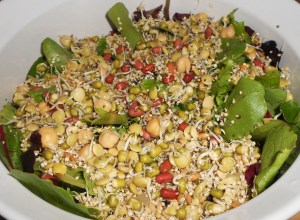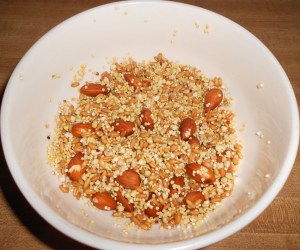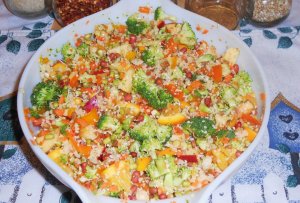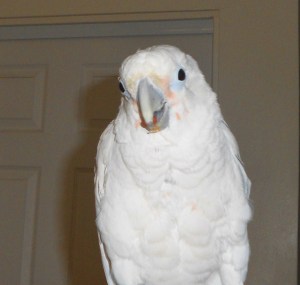Soaks and Sprouts: A Nutritional Powerhouse for Parrots by Michelle “Elle” Magnon
Starting at top, clockwise: Garbanzo beans, short grain brown rice, green lentils, wheat berries, mung beans, red lentils, buckwheat groats and adzuki beans in the center.
Soaking or sprouting seeds and grains are an easy way to provide your parrot with fresh live food that is similar to what they would be eating in the wild. All birds, from finches to macaws benefit from and enjoy eating these. There are different sizes and types available for every size of bird. By soaking dormant seeds they germinate and are brought back to life again. Sprouts are like little vegetable plants packed with antioxidants, vitamins, minerals, essential amino acids and protein. Did I mention that not only is this one of healthiest additions to your parrot’s diet, but it’s also one of the least expensive too?
Start easy, seeds and grains germinate and are ready to eat after just a rinse and overnight soaking. You can also continue to repeatedly rinse and drain them for a day in order to sprout root tails on them.
Some popular options to get you started:
wheat
oats
spelt
barely
millet
quinoa
buckwheat groats
sunflower seeds
short grain brown rice
sesame seeds
amaranth
corn kernels
Soaking overnight
24 hrs. later: The quinoa is already fully sprouted and ready, lentils are starting to sprout. The rest will take a couple more days.
Sprouts by jar in order: 1st – combo quinoa, millet and wheat berries; 2nd – mung beans; 3rd – almonds; 4rth – corn; 5th – buckwheat groats; 6th – lentils; 7th – garbanzo beans; 8th – brown rice
I must add that soaked almonds are a really special treat and it might be difficult for you to stay out of them yourself. I could never eat a plain dry almond again after having them soaked. Just soak overnight, rinse in the morning and they are ready to eat. They are fantastic, really, try it!
A homemade sprouts cereal: Quinoa, Millet, Spelt, Wheat Berries, Buckwheat Groats, Brown Rice, Sesame and Almond
How to get started:
Buy your seeds and grains from a health food store. Human-grade organic ingredients are safer, fresher and much better quality.
Just use a very small amount at a time. A little spoonful of seed goes a long way, and you want to make small amounts so you use them all up quickly when they are fresh and most nutritious.
Start by inspecting for any damaged broken seeds and toss them out. Put your seeds into a strainer and give them a good washing by running lots of fresh water through them. The fine mesh stainless steel strainers work really well.
Now put them in a clean glass container with plenty of cool fresh water. They will expand so add enough water to cover them completely. Soak for 6 to 9 hours. I prepare them just before bed and they soak overnight.
The next morning give them a good rinsing and drain them well. You now have nutritious, live, germinated seeds. That’s it, it really is that simple. Grains and seeds can be fed after just a simple soaking that bring them to life.
You may also choose to let them grow just a little further until they visually sprout. Rinse and drain very well at least three or four times a day until you see little buds of white sprout tails. This usually takes a day, maybe two.
Of course you can also toss some onto your own salad, sandwich or wrap. They are good in baked breads and in soups too. Just save some for the birds this was supposed to be for them.
Helpful Hints:
You can just use plain glass jars or bowls. Small mason jars work well. Glass is preferred over plastic, since glass can be cleaned and sanitized thoroughly.
Don’t cover your sprouts, they need fresh clean air during the entire soaking and sprouting process. Also keep them in a cool spot and out of direct sunlight.
Be sure to let your sprouts dry out before putting them in the refrigerator so they will keep nicely and stay fresh. Only make what you will be able to use that day or only store them in the refrigerator for a day or two at the most.
Most birds will love sprouts even if it is a new food for them. If your bird is stubborn about trying new foods typically your food on your plate is more enticing to them. Share with your bird and eat with them to get them to try new healthy foods.
Our house guest Happy enjoying veggies with sprouts
Our house guest Kabuki enjoying an adzuki bean sprout
Cautions:
Don’t forget about or neglect your growing sprouts. You’re making fresh live food. You don’t want to grow mold or bacteria in your sprouts. Rinsing very well and draining very well each day is crucial to the well being of your sprouts. Always wash your hands before handling sprouts. Sprouts should smell fresh and earthy, never foul or sour smelling. Toss them out if there is ever any question about their freshness.
As an extra precaution you can give your sprouts a rinse with white vinegar or grapefruit seed extract during your rinsing. Or sometimes I spray my sprouts with some apple cider vinegar just before feeding them to the parrots.
Once you feel comfortable and confident in sprouting you may want to sprout some legumes too. This includes garbanzo beans (chick peas), adzuki beans, mung beans and lentils. Legumes are not safe to eat when raw. You must be sure to sprout them until you see the root tails, this can take three or four days. Also be sure you are sprouting something that is actually safe and okay for parrots to eat. There are toxic beans that should never be sprouted so don’t experiment with something that you don’t know for sure is safe for parrots.
Sprouts with organic leafy greens

Getting more information:
Sprout People is my favorite sprouting site. They have a wealth of information and step by step instructions for every kind of sprout. They even have detailed instructional videos. I highly recommend them for anyone who is interested in sprouting.
Sprouts section for birds and other pets











Michelle, I’m looking at your list of things to sprout and I’m wondering about the quinoa, amaranth, and is it just the seeds from either a package or bin from the store, that I soak? This is probably a dumb question b/c I haven’t seen any other type of seeds from where I shop. Here in Toronto, we have some great, organic grocery and health food stores to choose from, but I do have my preference. Anyways, as I’m reading your instructions, it’s very easy starting out with just seeds. I have half a bag of quinoa on hand, so may start from there.
May 3, 2012 at 6:36 pm
Yes, you can get them from a package or the bins at the store. I have a great health food store near me that has a large variety and selection of organic bulk bin ingredients. I get most of my “bird food” there. Quinoa is very quick and easy to start with; soak a few to several hours, then rinse just one or two times and you will have lots of fresh nutritious sprouts.
May 5, 2012 at 10:20 am
Thanks, hun; yes, I also ONLY shop at the health food store for the foods; some foods are in bins, some packaged ….. I will try and let you know how it comes out; I think I’ll just start with a tablespoon or two or three, lol ….. wish me luck ;-D!!!
May 5, 2012 at 10:37 am
Yes, start small, just a spoonful or two. You want to make small amounts and they do expand quite a bit too. You just want to make enough for that day, or the next day or two.
May 5, 2012 at 10:47 am
Ooooo, ooooo, I also have the amaranth seeds, too ……. yaaaaa!!!
May 5, 2012 at 10:38 am
Have fun!
May 5, 2012 at 10:47 am
I’ll soak them overnight tonight, but just one more question ….. how much water should they be soaked in? Duuuuuh, sorry for pestering you but I want to ensure I do it correctly
May 5, 2012 at 11:04 am
I don’t measure it, just plenty of water to more than cover them, at least three or four times as much water. They will expand too, so leave air space at the top so it doesn’t spill over.
May 5, 2012 at 11:12 am
First time sprouter here, I rinsed the quinoa last night and soaked it overnight in a jar in a cool dark place. I’d like to sprout them to the point where I can see the tails, I know you say to continue to drain and rinse them 3-4 times a day, but do soak them still or should I be leaving them out of water to sprout? I’m seeing a lot of conflicting information regarding this online.
May 19, 2013 at 11:13 am
Hi Kalya, quinoa is so quick and easy, it would probably do fine staying in the water the whole time. But I normally just soak overnight, then do a few rinse and fully drain cycles, and it’s ready. Let me know how it comes out, and how they like it! 🙂
May 19, 2013 at 11:18 am
Pingback: The Twelve Days of Holiday Treats for Parrots (and Other Birds) | In Loco Parrotus